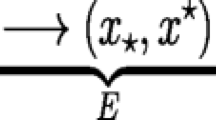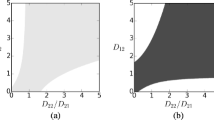Abstract
Predictions for climate change include movement of temperature isoclines up to 1000 m/year, and this is supported by recent empirical studies. This paper considers effects of a rapidly changing environment on competitive outcomes between species. The model is formulated as a system of nonlinear partial differential equations in a moving domain. Terms in the equations decribe competition interactions and random movement by individuals. Here the critical patch size and travelling wave speed for each species, calculated in the absence of competition and in a stationary habitat, play a role in determining the outcome of the process with competition and in a moving habitat. We demonstrate how habitat movement, coupled with edge effects, can open up a new niche for invaders that would be otherwise excluded.
Similar content being viewed by others
References
Abramowitz, M. and I. A. Stegun (Eds), (1965). Handbook of Mathematical Functions with Formulas, Graphs and Mathematical Tables, New York: Dover Publications.
Aronson, D. and H. Weinberger (1975). Nonlinear diffusion in population genetics, combustion, and nerve pulse propagation, in Lecture Notes in Mathematics, Springer, pp. 5–49.
Cantrell, R. S., C. Cosner and W. F. Fagan (1998). Competitive reversals inside ecological reserves: the role of external habitat degradation. J. Math. Biol. 37, 491–533.
Clark, J. S. et al. (1998). Reid’s paradox of rapid plant migration. BioScience 48, 13–24.
Durret, R. (2002). Mutual Invadability Implies Coexistence in Spatial Models, Memoirs of the American Mathematical Society number 740.
Fagan, W. F., R. S. Cantrell and C. Cosner (1999). How habitat edges change species interactions. Am. Naturalist 153, 165–182.
Levin, S. A. (1974). Dispersion and population interactions. Am. Naturalist 108, 207–228.
Lewis, A. M., B. Li and H. F. Weinberger (2002). Spreading speed and linear determinacy for two-species competition models. J. Math. Biol. 45, 219–233.
Ludwig, D., D. G. Aronson and H. F. Weinberger (1979). Spatial patterning of the spruce budworm. J. Math. Biol. 8, 217–258.
Malcolm, J. R. and A. Markham (2000). Global warming and terrestrial biodiversity decline. A Report Prepared for WWF (available online at http://panda.org/resources/publications/climate/speedkills).
Okubo, A. (1980). Diffusion and Ecological Problems: Mathematical Models, Berlin etc.: Springer.
Parmesan, C. and G. Yohe (2003). A globally coherent fingerprint of climate change impacts across natural systems. Nature 421, 37–42.
Shigesada, N. and K. Kawasaki (1997). Biological Invasions: Theory and Practice, Oxford: Oxford University Press.
Smith, H. L. and P. Waltman (1995). The Theory of the Chemostat, Cambridge: Cambridge University Press.
Smoller, J. (1994). Shock Waves and Reaction-Diffusion Equations, NY etc.: Springer.
Speirs, D. C. and W. S. C. Gurney (2001). Population persistence in rivers and estuaries. Ecology 82, 1219–1237.
Author information
Authors and Affiliations
Corresponding author
Rights and permissions
About this article
Cite this article
Potapov, A.B., Lewis, M.A. Climate and competition: The effect of moving range boundaries on habitat invasibility. Bull. Math. Biol. 66, 975–1008 (2004). https://doi.org/10.1016/j.bulm.2003.10.010
Received:
Accepted:
Issue Date:
DOI: https://doi.org/10.1016/j.bulm.2003.10.010




